2023届高三英语二轮复习:谓语动词的时态语态与主谓一致 课件(28张ppt)
文档属性
| 名称 | 2023届高三英语二轮复习:谓语动词的时态语态与主谓一致 课件(28张ppt) |  | |
| 格式 | pptx | ||
| 文件大小 | 1.7MB | ||
| 资源类型 | 教案 | ||
| 版本资源 | 通用版 | ||
| 科目 | 英语 | ||
| 更新时间 | 2022-09-30 16:01:38 | ||
图片预览

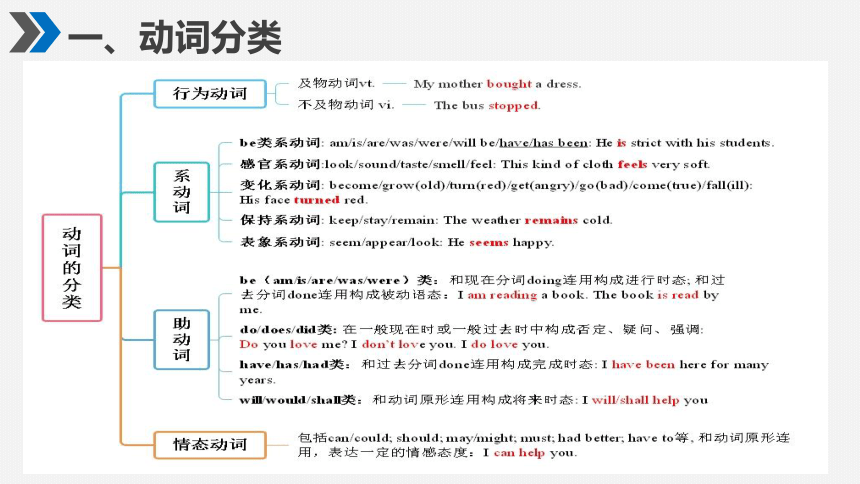
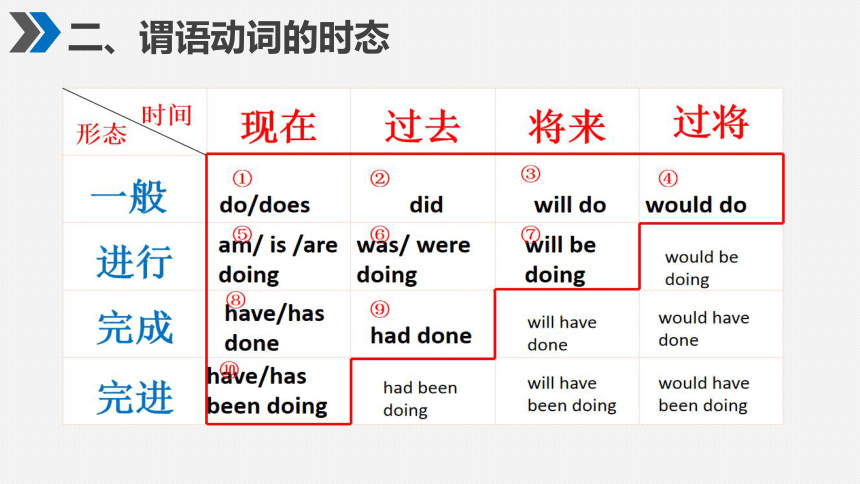
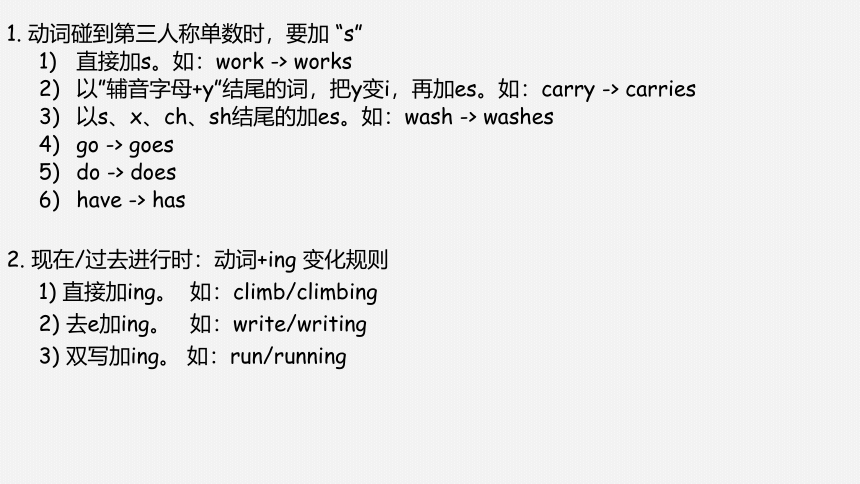
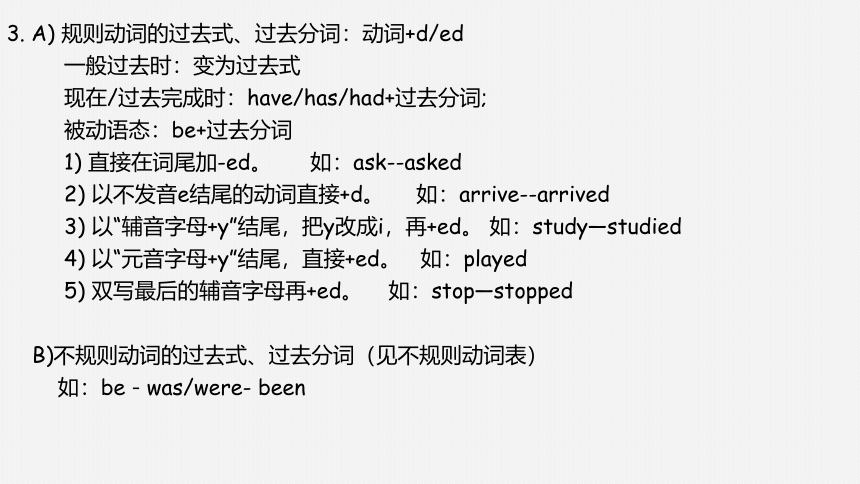



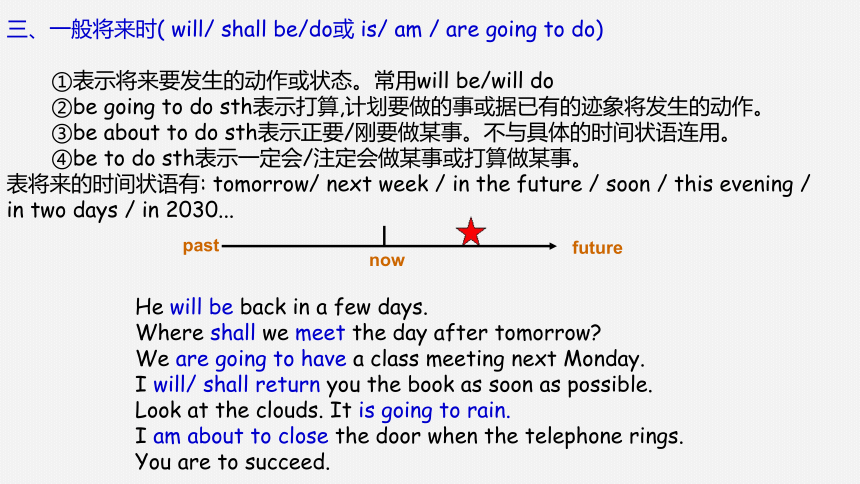
文档简介
(共28张PPT)
第6讲 谓语动词的时态、语态与主谓一致
一、动词分类
二、谓语动词的时态
1. 动词碰到第三人称单数时,要加 “s”
直接加s。如:work -> works
以”辅音字母+y”结尾的词,把y变i,再加es。如:carry -> carries
以s、x、ch、sh结尾的加es。如:wash -> washes
go -> goes
do -> does
have -> has
2. 现在/过去进行时:动词+ing 变化规则
1) 直接加ing。 如:climb/climbing
2) 去e加ing。 如:write/writing
3) 双写加ing。 如:run/running
3. A) 规则动词的过去式、过去分词:动词+d/ed
一般过去时:变为过去式
现在/过去完成时:have/has/had+过去分词;
被动语态:be+过去分词
1) 直接在词尾加-ed。 如:ask--asked
2) 以不发音e结尾的动词直接+d。 如:arrive--arrived
3) 以“辅音字母+y”结尾,把y改成i,再+ed。 如:study—studied
4) 以“元音字母+y”结尾,直接+ed。 如:played
5) 双写最后的辅音字母再+ed。 如:stop—stopped
B)不规则动词的过去式、过去分词(见不规则动词表)
如:be-was/were- been
二、谓语动词的时态
一、一般现在时 (am/is/are; do/ does)
①表示客观事实或真理
②表示经常性或习惯性发生的动作或状态(常用的时间状语有sometimes / often / always /usually/ seldom/ every (morning…) / on Sundays / in the morning等 )
③在时间和条件状语从句中代表一般将来时
future
past
now
I am teacher.
The earth moves around the sun.
Water boils at 100℃.
We always care for each other and help each other.
The shop closes at 11:00 p.m. every day.
Columbus proved that the earth is round.
If you are free tomorrow, I'll go with you.
future
past
now
二、一般过去时 (was/were; did)
表示过去发生的动作或状态或过去经常习惯性发生的动作。常与表示过去具体的时间
状语连用(或有上下文语境暗示)。时间状语有: last week / two days ago / the other
day / in 1990 /this morning / just now/ in the past/ yesterday等。
注意: 凡有具体的过去时间状语的通常用一般过去时
I met him in the street yesterday.
The students went to the Great Wall last Sunday.
When she was in Shanghai, she often came to see me.
We often played Ping-pong when we were in college.
Our teacher told us that Columbus discovered America in 1492.
future
past
now
三、一般将来时( will/ shall be/do或 is/ am / are going to do)
①表示将来要发生的动作或状态。常用will be/will do
②be going to do sth表示打算,计划要做的事或据已有的迹象将发生的动作。
③be about to do sth表示正要/刚要做某事。不与具体的时间状语连用。
④be to do sth表示一定会/注定会做某事或打算做某事。
表将来的时间状语有: tomorrow/ next week / in the future / soon / this evening /
in two days / in 2030...
He will be back in a few days.
Where shall we meet the day after tomorrow
We are going to have a class meeting next Monday.
I will/ shall return you the book as soon as possible.
Look at the clouds. It is going to rain.
I am about to close the door when the telephone rings.
You are to succeed.
四、过去将来时 ( would be/do 或 was/ were going to do)
表示从过去的某一时间看将来要发生的动作或状态,常用语宾语从句当中。
即:在过去看将来
future
past
now
I thought they would come to help me.
They knew that there was going to be several problems.
They told me that they would have a class meeting.
She said that she would go there by herself.
练习
1.The festival traditionally __________(begin) on the first day of the first month in the Chinese calendar and ends with Lantern Festival which is on the fifth day.
2.(2019年全国Ⅲ卷·65) Our hosts shared many of their experiences and _____________ (recommend) wonderful places to eat, shop, and visit.
3.He __________(attend) an important meeting next Saturday.
4.If their marketing plans succeed, they _____________(increase)their sales by 20 percent.
5.He said that he__________ (come) back in five minutes.
begins
recommended
will attend
will increase
would come
二、谓语动词的时态
future
past
now
五、现在进行时( is / am / are doing ) “正...”
①表示说话时正在进行或现阶段正在进行的动作。常用的时间状语有: now, at present, at the moment...
②表示按计划或安排即将进行的动作,表示这种动作的动词有:come, go, leave, arrive,
start, see等,并常与表示将来时间的状语连用。即:现在进行时表将来
We are having our English class now.
I’m looking for a pair of black shoes.
They are working in a factory these days.
I’m writing a book about English grammar.
They are visiting Beijing this week.
The weather is getting colder and colder.
六、过去进行时 ( was / were doing)
①表示过去某一时刻或某一段时间正在进行或发生的动作。常用的时间状语有:at that
time/ at this time yesterday/ from nine to ten yesterday evening/ all day
yesterday/ the whole morning/ ...
②某一动作发生时另一动作正在发生,常用在由when或while引导的时间状语从句中。
future
past
now
At that time, he was working in a university.
What were you doing at this time yesterday
He was reading a novel in the library this morning.
When I entered the room, she was sitting at her desk.
七、将来进行时 ( will be doing)
表示在将来某一时刻或某一段时间正在进行或发生的动作。常用的时间状语有: at this
time tomorrow/ from nine to ten tomorrow evening/ all day tomorrow/...
future
past
now
At this time tomorrow, I will be lying on the beach.
练习
1. Look, the children __________(play) basketball on the playground.
2. He__________(listen) to the radio when I came in.
are playing
was listening
二、谓语动词的时态
七、现在完成时 ( have / has done) “已经...”
1) 表示过去的动作对现在的影响和结果。
future
past
now
He has already finished his work.
We have visited the city three times.
I have seen this film.
2) 表示从过去某一时刻持续到现在的动作或状态。常用的时间状语有: for five years/ since two days ago/ so far/ by now/ till now/up to now / recently/ lately/ in the past ten years.
注意: 短暂性动作不能与表示段时间连用,如: borrow-have
future
past
now
动作 leave die marry join begin
状态 be away be dead be married be in be on
I have studied English for six years.
They have lived in the city since 1988.
---How long have you been here 你到这儿多长时间了
---I have been here for an hour. 我到这儿一个小时了。
have arrived
×
九、过去完成时 ( had done)
1) 表示在过去某一时间或动作之前已发生或完成的动作。即动作发生的时间是 ”过去的过去“。
future
past
now
We had learnt 30 lessons by the end of last month.
He found the book that he had lost.
I didn’t know I had given you so much trouble.
Until then, he had known nothing about it.
After he (had) finished his work, he went to bed.
2) 表示从过去某一时间延续到另一过去时间的动作。常用的时间状语有: by +过去时间( then/ the end of last month/ by the time we got home/…)
future
past
now
When he came, I had worked for 3 hours.
She had only been here for ten minutes when Jim came in.
The boy told his mother that he had been ill since he came back from the school.
had been working
十、现在完成时 ( have / has been doing)
表示从过去某一时刻一直持续到现在的动作或状态。有时可与现在完成时的第二种用法互换。
future
past
now
I have been waiting for you all afternoon.
He has been playing the guitar since he was five.
练习
1.(2022年全国甲卷·67)In the last five years, Cao __________ (walk) through 34 countries in six continents, and in 2016, he reached the top of Kilimanjaro, Africa's highest mountain.
2.(2018年全国Ⅱ卷·61) Since 2011, the country ___________ (grow) more corn than rice.
3.(2020年浙江卷)By about 6000 BC,people ___________ (discover)the best crops to grow and animals to raise.
has walked
has grown
had discovered
三、被动语态
练习
1.Drivers __________(require) to switch off their mobile phone while driving nowadays.
2.(2021年全国甲卷·61)It__________ (build) originally to protect the city in the Tang dynasty and has now been completely restored (修复).
3.(2017年全国Ⅰ卷·64) When fat and salt _____________(remove) from food, the food tastes as if it is missing something.
4.(2016 全国II卷·62)Truly elegant chopsticks might________(make) of gold and silver with Chinese characters.
are required
was built
are removed
be made
四、主谓一致
练习
1.The number of people invited to the party ____________(be) fifty, but a number of them ____________(be) absent for different reasons.
2.Not only the mother but also the children ____________(be) there then.
3.There __________(be) lots of people at the restaurant when I got there.
4.(2016全国II卷·63)Leaving the less important things until tomorrow_______(be) often acceptable.
5. The police_______(be) determined to bring back the thieves in order for further investigation.
is
are
were
were
is
were
THANK YOU!
第6讲 谓语动词的时态、语态与主谓一致
一、动词分类
二、谓语动词的时态
1. 动词碰到第三人称单数时,要加 “s”
直接加s。如:work -> works
以”辅音字母+y”结尾的词,把y变i,再加es。如:carry -> carries
以s、x、ch、sh结尾的加es。如:wash -> washes
go -> goes
do -> does
have -> has
2. 现在/过去进行时:动词+ing 变化规则
1) 直接加ing。 如:climb/climbing
2) 去e加ing。 如:write/writing
3) 双写加ing。 如:run/running
3. A) 规则动词的过去式、过去分词:动词+d/ed
一般过去时:变为过去式
现在/过去完成时:have/has/had+过去分词;
被动语态:be+过去分词
1) 直接在词尾加-ed。 如:ask--asked
2) 以不发音e结尾的动词直接+d。 如:arrive--arrived
3) 以“辅音字母+y”结尾,把y改成i,再+ed。 如:study—studied
4) 以“元音字母+y”结尾,直接+ed。 如:played
5) 双写最后的辅音字母再+ed。 如:stop—stopped
B)不规则动词的过去式、过去分词(见不规则动词表)
如:be-was/were- been
二、谓语动词的时态
一、一般现在时 (am/is/are; do/ does)
①表示客观事实或真理
②表示经常性或习惯性发生的动作或状态(常用的时间状语有sometimes / often / always /usually/ seldom/ every (morning…) / on Sundays / in the morning等 )
③在时间和条件状语从句中代表一般将来时
future
past
now
I am teacher.
The earth moves around the sun.
Water boils at 100℃.
We always care for each other and help each other.
The shop closes at 11:00 p.m. every day.
Columbus proved that the earth is round.
If you are free tomorrow, I'll go with you.
future
past
now
二、一般过去时 (was/were; did)
表示过去发生的动作或状态或过去经常习惯性发生的动作。常与表示过去具体的时间
状语连用(或有上下文语境暗示)。时间状语有: last week / two days ago / the other
day / in 1990 /this morning / just now/ in the past/ yesterday等。
注意: 凡有具体的过去时间状语的通常用一般过去时
I met him in the street yesterday.
The students went to the Great Wall last Sunday.
When she was in Shanghai, she often came to see me.
We often played Ping-pong when we were in college.
Our teacher told us that Columbus discovered America in 1492.
future
past
now
三、一般将来时( will/ shall be/do或 is/ am / are going to do)
①表示将来要发生的动作或状态。常用will be/will do
②be going to do sth表示打算,计划要做的事或据已有的迹象将发生的动作。
③be about to do sth表示正要/刚要做某事。不与具体的时间状语连用。
④be to do sth表示一定会/注定会做某事或打算做某事。
表将来的时间状语有: tomorrow/ next week / in the future / soon / this evening /
in two days / in 2030...
He will be back in a few days.
Where shall we meet the day after tomorrow
We are going to have a class meeting next Monday.
I will/ shall return you the book as soon as possible.
Look at the clouds. It is going to rain.
I am about to close the door when the telephone rings.
You are to succeed.
四、过去将来时 ( would be/do 或 was/ were going to do)
表示从过去的某一时间看将来要发生的动作或状态,常用语宾语从句当中。
即:在过去看将来
future
past
now
I thought they would come to help me.
They knew that there was going to be several problems.
They told me that they would have a class meeting.
She said that she would go there by herself.
练习
1.The festival traditionally __________(begin) on the first day of the first month in the Chinese calendar and ends with Lantern Festival which is on the fifth day.
2.(2019年全国Ⅲ卷·65) Our hosts shared many of their experiences and _____________ (recommend) wonderful places to eat, shop, and visit.
3.He __________(attend) an important meeting next Saturday.
4.If their marketing plans succeed, they _____________(increase)their sales by 20 percent.
5.He said that he__________ (come) back in five minutes.
begins
recommended
will attend
will increase
would come
二、谓语动词的时态
future
past
now
五、现在进行时( is / am / are doing ) “正...”
①表示说话时正在进行或现阶段正在进行的动作。常用的时间状语有: now, at present, at the moment...
②表示按计划或安排即将进行的动作,表示这种动作的动词有:come, go, leave, arrive,
start, see等,并常与表示将来时间的状语连用。即:现在进行时表将来
We are having our English class now.
I’m looking for a pair of black shoes.
They are working in a factory these days.
I’m writing a book about English grammar.
They are visiting Beijing this week.
The weather is getting colder and colder.
六、过去进行时 ( was / were doing)
①表示过去某一时刻或某一段时间正在进行或发生的动作。常用的时间状语有:at that
time/ at this time yesterday/ from nine to ten yesterday evening/ all day
yesterday/ the whole morning/ ...
②某一动作发生时另一动作正在发生,常用在由when或while引导的时间状语从句中。
future
past
now
At that time, he was working in a university.
What were you doing at this time yesterday
He was reading a novel in the library this morning.
When I entered the room, she was sitting at her desk.
七、将来进行时 ( will be doing)
表示在将来某一时刻或某一段时间正在进行或发生的动作。常用的时间状语有: at this
time tomorrow/ from nine to ten tomorrow evening/ all day tomorrow/...
future
past
now
At this time tomorrow, I will be lying on the beach.
练习
1. Look, the children __________(play) basketball on the playground.
2. He__________(listen) to the radio when I came in.
are playing
was listening
二、谓语动词的时态
七、现在完成时 ( have / has done) “已经...”
1) 表示过去的动作对现在的影响和结果。
future
past
now
He has already finished his work.
We have visited the city three times.
I have seen this film.
2) 表示从过去某一时刻持续到现在的动作或状态。常用的时间状语有: for five years/ since two days ago/ so far/ by now/ till now/up to now / recently/ lately/ in the past ten years.
注意: 短暂性动作不能与表示段时间连用,如: borrow-have
future
past
now
动作 leave die marry join begin
状态 be away be dead be married be in be on
I have studied English for six years.
They have lived in the city since 1988.
---How long have you been here 你到这儿多长时间了
---I have been here for an hour. 我到这儿一个小时了。
have arrived
×
九、过去完成时 ( had done)
1) 表示在过去某一时间或动作之前已发生或完成的动作。即动作发生的时间是 ”过去的过去“。
future
past
now
We had learnt 30 lessons by the end of last month.
He found the book that he had lost.
I didn’t know I had given you so much trouble.
Until then, he had known nothing about it.
After he (had) finished his work, he went to bed.
2) 表示从过去某一时间延续到另一过去时间的动作。常用的时间状语有: by +过去时间( then/ the end of last month/ by the time we got home/…)
future
past
now
When he came, I had worked for 3 hours.
She had only been here for ten minutes when Jim came in.
The boy told his mother that he had been ill since he came back from the school.
had been working
十、现在完成时 ( have / has been doing)
表示从过去某一时刻一直持续到现在的动作或状态。有时可与现在完成时的第二种用法互换。
future
past
now
I have been waiting for you all afternoon.
He has been playing the guitar since he was five.
练习
1.(2022年全国甲卷·67)In the last five years, Cao __________ (walk) through 34 countries in six continents, and in 2016, he reached the top of Kilimanjaro, Africa's highest mountain.
2.(2018年全国Ⅱ卷·61) Since 2011, the country ___________ (grow) more corn than rice.
3.(2020年浙江卷)By about 6000 BC,people ___________ (discover)the best crops to grow and animals to raise.
has walked
has grown
had discovered
三、被动语态
练习
1.Drivers __________(require) to switch off their mobile phone while driving nowadays.
2.(2021年全国甲卷·61)It__________ (build) originally to protect the city in the Tang dynasty and has now been completely restored (修复).
3.(2017年全国Ⅰ卷·64) When fat and salt _____________(remove) from food, the food tastes as if it is missing something.
4.(2016 全国II卷·62)Truly elegant chopsticks might________(make) of gold and silver with Chinese characters.
are required
was built
are removed
be made
四、主谓一致
练习
1.The number of people invited to the party ____________(be) fifty, but a number of them ____________(be) absent for different reasons.
2.Not only the mother but also the children ____________(be) there then.
3.There __________(be) lots of people at the restaurant when I got there.
4.(2016全国II卷·63)Leaving the less important things until tomorrow_______(be) often acceptable.
5. The police_______(be) determined to bring back the thieves in order for further investigation.
is
are
were
were
is
were
THANK YOU!
